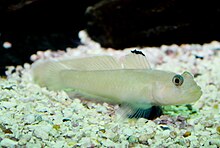Goby
| Gobies | |
|---|---|
 |
|
| The blackeye goby (Rhinogobiops nicholsii) | |
| Scientific classification | |
| Kingdom: | Animalia |
| Phylum: | Chordata |
| Class: | Actinopterygii |
| Order: | Perciformes |
| Suborder: | Gobioidei |
| Family: |
Gobiidae G. Cuvier, 1816 |
| Subfamilies | |
|
See text. |
|
See text.
Gobies are fishes of the family Gobiidae, one of the largest fish families comprising more than 2,000 species in more than 200 genera. Most of them are relatively small, typically less than 10 cm (3.9 in) in length. Gobies include some of the smallest vertebrates in the world, such as Trimmatom nanus and Pandaka pygmaea, which are under 1 cm (3⁄8 in) long when fully grown. Some large gobies, such as some species of the genera Gobioides or Periophthalmodon, can reach over 30 cm (0.98 ft) in length, but that is exceptional. Generally, they are benthic, or bottom-dwellers. Although few are important as food for humans, they are of great significance as prey species for commercially important fish such as cod, haddock, sea bass, and flatfish. Several gobies are also of interest as aquarium fish, such as the bumblebee gobies of the genus Brachygobius. Phylogenetic relationships of gobies have been studied using molecular data.
The most distinctive aspects of goby morphology are the fused pelvic fins that form a disc-shaped sucker. This sucker is functionally analogous to the dorsal fin sucker possessed by the remoras or the pelvic fin sucker of the lumpsuckers, but is anatomically distinct; these similarities are the product of convergent evolution. Gobies can often be seen using the sucker to adhere to rocks and corals, and in aquariums they will stick to glass walls of the tank, as well.
...
Wikipedia
